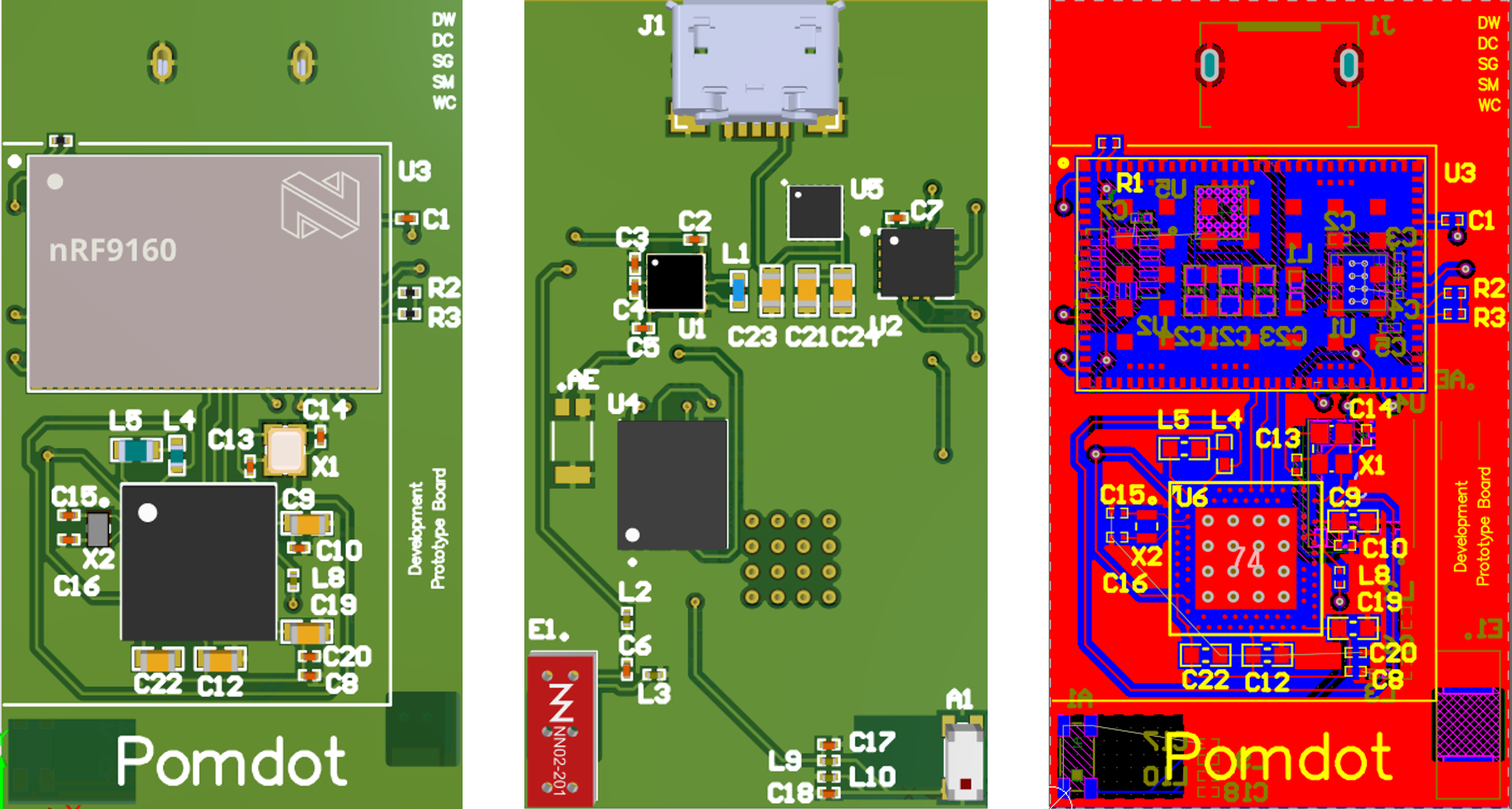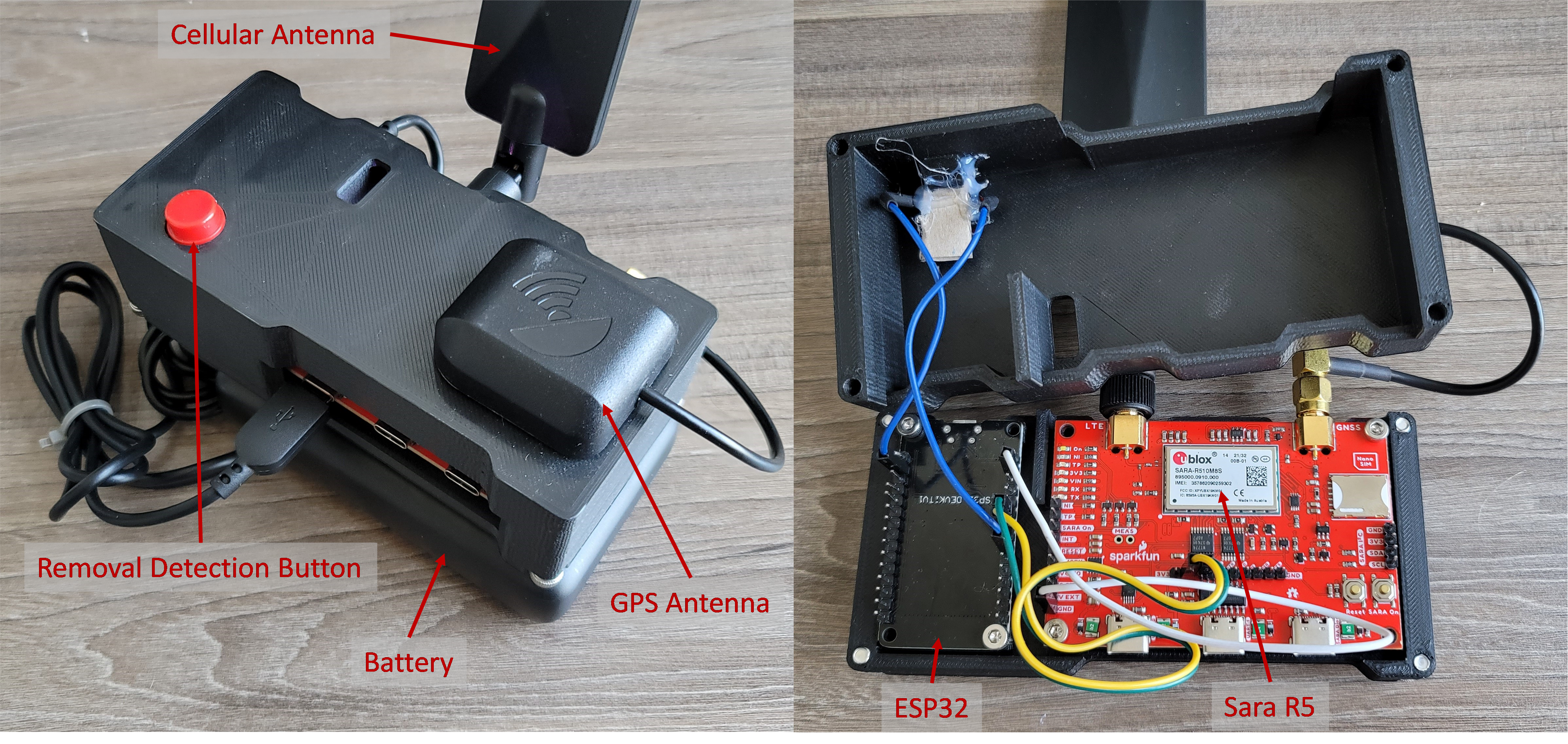Table of Contents
- Table of Contents
- Introduction
- Customer Research
- Mechanical Design
- Electrical Design
- Software Design
- Capstone Results
Introduction
As a main component of my Georgia Tech Senior Capstone (my thoughts on which are summarized in my coursework post) my team developed a children’s safety wearable. CreateX Capstone focuses heavily on entrepreneurship and finding problems worth solving, so a considerable portion of the project was devoted to problem identification and customer interviews. My team (composed of myself (ME), Dustin Coha (ME), Sathya Gummadi (EE), Sandeepan Mukherjee (ME), and Dillon Wells (ME)) was dominantly mechanical engineering, but with Dillon and I having significant software/firmware development experience, and Dustin and Sandeepan having strong mechanical design backgrounds. Following problem identification, our team split into three main sub-teams, which collaborated to create and integrate mechanical, electrical, and software prototypes for our device. A strong approval and push from some mentors to start a company caused our team to considered pursuing the development of the device full-time, but ultimately most of our members were more comfortable sticking with post-graduation opportunities they had already obtained (I, for instance, have already committed to pursuing my Ph.D. in Controls and Dynamical Systems at Caltech). As such, our Capstone Reports and much of our prototyping materials have been open-sourced on my github repo, located here.
Customer Research
Our team, despite being predominantly mechanical engineers, had a diverse background, and pursued a wide variety of problem spaces initially. My research background in rehabilitation and mobility devices led to many interviews with physical therapists. Other teammates led directions such as worker safety, automobile safety, cycling, and other customer groups. Finally, our team got the most consistent and robust feedback from a very large customer group - parents. We continued to dive deeper into this realm, looking into infant safety, toddler safety, and child safety. Eventually, we focused on designing a product which provided real-time location data of a child’s whereabouts to parents, via a wearable device. There are few products on the market aimed at solving this problem for families, though they lack performance in three key areas: durability, battery life, and ability to stay with the child. Specifically, children three to ten years old are rough with what they are wearing, parents want batteries to last for at least a few days, and kids try to take things off themselves all the time. Current products are simply not engineered to stand up to the wear and tear of daily childhood existence while also delivering the location tracking services parents want in an affordable, comfortable form factor.
Mechanical Design
 The mechanical design focused around making a durable, robust, comfortable design, which was adjustable, implemented unauthorized removal detection, and had an optional clasping mechanism which would be difficult for a child to remove.
The mechanical design focused around making a durable, robust, comfortable design, which was adjustable, implemented unauthorized removal detection, and had an optional clasping mechanism which would be difficult for a child to remove.
Adjustability was integrated by a simple peg system on the underside of the wearable, where the number of pegs on the band could be changed to alter the band size through several discrete intervals. This mechanism was easy to implement and manufacture, integrated well with the continuity band for removal detection, and allowed the device to maintain a low form factor.
Unauthorized removal detection was accomplished by running a thin continuous with throughout the wearable’s band, which connections being made in the adjustable pegs and the clasp mechanism. If the clasp is removed or the wearable’s band is cut, the continuity is broken, and the wearable triggers and alert on the parent’s smartphone.
The child-proof clasping mechanism was somewhat polarizing among reviewers - several parents loved the idea of being able to essentially lock something on their child, to prevent it from being lost or mistreated, while many of our peers (notably not parents themselves) viewed this as an invasion of privacy. With polarizing reviews from both sides, we implemented an optional childproof clasp, which requires two hands to remove. Therefore, when it is on the child’s wrist, they only have one hand available to remove it (this design is actually adult-proof as well, no one we put it on has been able to take it off themselves). The wearable can alternatively be designed with a quick-release clasp mechanism. The specifics of the mechanism are detailed in the technical reports, for the interested reader.
Electrical Design
 The main focuses of the electrical design are the ability to communicate location data wirelessly and long battery life. To accomplish this, the device is equipped with a GPS receiver to determine the device’s location, as well as a bluetooth chip, for short-range communication with the parent smartphone, and a cellular chip for long-range communication. Switching to Bluetooth Low-Energy (BLE) when in range of the smartphone offers significant power savings over cellular communication. Additionally, an accelerometer is placed on the PCB, which can be used to perform other intelligent power-saving techniques, such as adaptive GPS rate sampling, or adaptive location publishing rates, depending on the motion characteristics of the device (this can additionally be used to put the device into a sleep mode when not moving, and wake the device upon motion). A power budget analysis of the device determined the theoretical battery life to be around 7 days. The specifics of the electrical implementation are detailed in the technical reports for the interested reader.
The main focuses of the electrical design are the ability to communicate location data wirelessly and long battery life. To accomplish this, the device is equipped with a GPS receiver to determine the device’s location, as well as a bluetooth chip, for short-range communication with the parent smartphone, and a cellular chip for long-range communication. Switching to Bluetooth Low-Energy (BLE) when in range of the smartphone offers significant power savings over cellular communication. Additionally, an accelerometer is placed on the PCB, which can be used to perform other intelligent power-saving techniques, such as adaptive GPS rate sampling, or adaptive location publishing rates, depending on the motion characteristics of the device (this can additionally be used to put the device into a sleep mode when not moving, and wake the device upon motion). A power budget analysis of the device determined the theoretical battery life to be around 7 days. The specifics of the electrical implementation are detailed in the technical reports for the interested reader.

Additionally, we implemented a medium-fidelity prototype of the electronics package, which used several (large) breakout boards and antennae to capture the key functionalities of the device in a package for demonstration of data flow through the system. It hit all of the major components: BLE and Cellular communication, GPS location, and a removal detection circuit. It interfaced successfully with our companion app, and served as an excellent demonstration piece in our presentations.
Software Design
I led up most of the software development for our team. This was composed of a companion smartphone app, which interacted with our medium-fidelity electronics prototype, and was used during demonstrations. The app was developed using Android Studio, and plotted both the location of the smartphone and the child safety device on a map. The location of the device was communicated over BLE when the device was in range, and over cellular data when the device was out of range. The app also handled automatic bluetooth reconnection.
 Additionally, the software team developed the firmware for the medium electronics prototype, which included maintaining a BLE Gatt to communicate with the smartphone app, handling cellular communication when the Gatt was disconnected, and interacting with the GPS chip to obtain location data. Overall the development task for both software components was straightforward, although I personally had to do a fair bit of learning regarding Android app development, with is something I had never touched before. It was not to difficult to pick up if one is already comfortable with the core principles of Object-Oriented and Event-Driven programming. As noted before, the code developed for this project is available fore viewing here.
Additionally, the software team developed the firmware for the medium electronics prototype, which included maintaining a BLE Gatt to communicate with the smartphone app, handling cellular communication when the Gatt was disconnected, and interacting with the GPS chip to obtain location data. Overall the development task for both software components was straightforward, although I personally had to do a fair bit of learning regarding Android app development, with is something I had never touched before. It was not to difficult to pick up if one is already comfortable with the core principles of Object-Oriented and Event-Driven programming. As noted before, the code developed for this project is available fore viewing here.
Capstone Results
The results of the capstone project varied a bit throughout the semester. In general, our peers often were resistent to the ideas regarding tracking and personal privacy of children. Additionally, much of our initial feedback pointed to the market for these devices being ‘saturated,’ although all of our customer interviews disagreed, with the majority of parents either having not heard of, or had bad experiences with, competing products. By designing our device to specifically combat many of the arguments parents had with other devices, namely removing the screen, games, and other unnecessary features (distractions) while increasing the durability and battery life, many parents were quite enthused by our design. By the end of the semester, we were getting incredible feedback from parents, as well as strong feedback from our advisors. One of the judges of the CreateX capstone voted our project best overall, and worked with us to join startup launch and connect with some investors; we ended up turning down these entrepreneurial opportunities to pursue opportunities we had already secured (graduate school, jobs, ect.), but it did feel nice to have interest in our ideas and be complimented on our execution.
